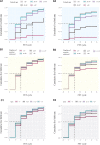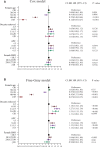The cumulative live birth rates of 18 593 women with progestin-primed ovarian stimulation-related protocols and frozen-thawed transfer cycles
- PMID: 38188854
- PMCID: PMC10769816
- DOI: 10.1093/hropen/hoad051
The cumulative live birth rates of 18 593 women with progestin-primed ovarian stimulation-related protocols and frozen-thawed transfer cycles
Abstract
Study question: What are the odds of achieving pregnancy when adopting progestin-primed ovarian stimulation (PPOS)-related protocols combined with repetitive frozen-thawed transfer (FET) cycles in patients with different clinical characteristics?
Summary answer: The cumulative live birth rates (CLBRs) of women undergoing different PPOS-related protocols can be significantly and consistently enhanced within six FET cycles when the female age is <40 years (or even <45 years) and when >5 oocytes are retrieved, regardless of antral follicle count (AFC).
What is known already: There have been numerous studies on the live birth rate of the first FET cycle in patients with PPOS-related protocols. These studies have focused mainly on comparing pregnancy outcomes with those of other stimulation protocols. However, owing to the unique features of the PPOS-related strategy, such as its flexible timing of oocyte retrieval and repeated transfer of frozen embryos, studies using the CLBR as an overall indicator of success and investigating which types of patients would benefit from this protocol are lacking.
Study design size duration: This retrospective cohort study included 18 593 women who underwent PPOS-related protocols (dydrogesterone + hMG, medroxyprogesterone acetate + hMG, micronized progesterone + hMG treatment, and luteal-phase ovarian stimulation protocol) from 1 March 2011 to 31 September 2022 in our centre.
Participants/materials setting methods: The population was categorized by female age, number of oocytes retrieved, and AFC in the analysis of CLBR within six FET cycles. The age groups (Groups 1-5, respectively) were <30, 30-34, 35-39, 40-44, and ≥45 years. The number of oocytes retrieved was grouped as 1-5, 6-10, 11-15, 16-20, and >20. AFC was grouped as <5, 5-10, 11-15, and >15. The Kaplan-Meier analysis (optimistic method), which hypothesized that patients who did not continue treatment had the same chance of achieving a live birth as those who continued, and the competing risk method (conservative method) which hypothesized they had no chance of achieving a live birth, were applied. In further analyses, the Cox model and Fine-Gray model were adopted: the former corresponds to the optimistic scenario, and the latter corresponds to the pessimistic scenario.
Main results and the role of chance: CLBR had a declining trend with female age over six FET cycles (Groups 1-5, respectively: optimistic: 96.9%, 96.6%, 91.4%, 67.3%, and 11.7%; conservative: 87.3%, 85.0%, 74.0%, 41.3%, and 7.5%), requiring more FET cycles to achieve a success rate of at least 50% (Groups 1-5, respectively: optimistic: 2, 2, 2, 4, and >6 cycles; conservative: 2, 2, 2, >,6 and >6 cycles). CLBR showed an increasing trend with the number of oocytes retrieved (Groups 1-5, respectively: optimistic: 93.8%, 94.3%, 95.8%, 96.0%, and 95.6%; conservative: 66.2%, 78.3%, 85.6%, 88.9%, and 91.0%). All groups needed the same number of FET cycles to achieve a success rate of at least 50% (Groups 1-5, respectively: optimistic: 2, 2, 2, 2, and 2 cycles; conservative: 2, 2, 2, 2, and 2 cycles). Furthermore, the CLBR within six FET cycles had an increasing trend with AFC number (Groups 1-4, respectively: optimistic: 89.2%, 94.8%, 95.9%, and 96.3%; conservative: 67.4%, 78.2%, 83.9%, and 88.1%), with all four groups achieving a success rate of at least 50% by the second FET cycle.
Limitations reasons for caution: The current research is limited by its retrospective design and single-centre nature, which may restrict the generalizability of our findings.
Wider implications of the findings: This work describes two models (the Kaplan-Meier analysis and the competing risk method) to evaluate the clinical outcome of patients using PPOS-related protocols, which are especially useful for patients of advanced age or those with diminished ovarian reserve. Our findings encourage patients below 45 years old, especially younger than 40 years, and patients with lower AFCs and fewer retrieved oocytes to try this new protocol. Moreover, this study demonstrates the degree of improvement in the CLBR within six FET cycles for patients with different clinical characteristics, providing a valuable point of reference to determine whether to continue ART after a transfer failure.
Study funding/competing interests: The study was supported by grants from the National Natural Science Foundation of China (82071603 to L.W., 82001502 to Y.L.). There are no conflicts of interest to declare.
Trial registration number: N/A.
Keywords: ART; ICSI; IVF; cumulative live birth rate; frozen embryo transfer; progestin-primed ovarian stimulation-related protocol.
© The Author(s) 2023. Published by Oxford University Press on behalf of European Society of Human Reproduction and Embryology.
Conflict of interest statement
The authors declare no conflicts of interest.
Figures



Similar articles
-
Women may not benefit from repeated frozen embryo transfers: a retrospective analysis of the cumulative live birth rate of 43 972 women.Hum Reprod Open. 2024 Oct 28;2024(4):hoae063. doi: 10.1093/hropen/hoae063. eCollection 2024. Hum Reprod Open. 2024. PMID: 39539356 Free PMC article.
-
Cumulative live birth rates after one ART cycle including all subsequent frozen-thaw cycles in 1050 women: secondary outcome of an RCT comparing GnRH-antagonist and GnRH-agonist protocols.Hum Reprod. 2017 Mar 1;32(3):556-567. doi: 10.1093/humrep/dew358. Hum Reprod. 2017. PMID: 28130435 Clinical Trial.
-
New application of dydrogesterone as a part of a progestin-primed ovarian stimulation protocol for IVF: a randomized controlled trial including 516 first IVF/ICSI cycles.Hum Reprod. 2018 Feb 1;33(2):229-237. doi: 10.1093/humrep/dex367. Hum Reprod. 2018. PMID: 29300975 Clinical Trial.
-
Cytoplasmic sperm injection (ICSI) - A systematic review of the literature.Gynecol Endocrinol. 2024 Dec;40(1):2414783. doi: 10.1080/09513590.2024.2414783. Epub 2024 Oct 19. Gynecol Endocrinol. 2024. PMID: 39425982
-
Progestin-primed ovarian stimulation: for whom, when and how?Reprod Biomed Online. 2024 Feb;48(2):103639. doi: 10.1016/j.rbmo.2023.103639. Epub 2023 Oct 22. Reprod Biomed Online. 2024. PMID: 38159467 Review.
Cited by
-
A valuable predictive model for optimizing the timing of oocyte retrieval: a retrospective analysis of oocyte retrieval time in 49,961 oocyte pickup (OPU) cycles.Reprod Biol Endocrinol. 2025 Jul 23;23(1):107. doi: 10.1186/s12958-025-01441-9. Reprod Biol Endocrinol. 2025. PMID: 40702558 Free PMC article.
-
Cumulative Live Birth Rates in Women Undergoing Progestin-Primed Ovarian Stimulation Using Medroxyprogesterone Acetate, Dydrogesterone, and Progesterone: A Retrospective Analysis.Drug Des Devel Ther. 2025 Jun 18;19:5193-5207. doi: 10.2147/DDDT.S523076. eCollection 2025. Drug Des Devel Ther. 2025. PMID: 40552092 Free PMC article.
-
Serum concentrations of medroxyprogesterone acetate were undetectable on OPU+5 days and had no effect on the serum progesterone level in patients undergoing the progestin-primed ovarian stimulation protocol.Front Endocrinol (Lausanne). 2025 May 14;16:1490839. doi: 10.3389/fendo.2025.1490839. eCollection 2025. Front Endocrinol (Lausanne). 2025. PMID: 40438399 Free PMC article.
References
-
- Bosch E, Labarta E, Crespo J, Simón C, Remohí J, Jenkins J, Pellicer A.. Circulating progesterone levels and ongoing pregnancy rates in controlled ovarian stimulation cycles for in vitro fertilization: analysis of over 4000 cycles. Hum Reprod 2010;25:2092–2100. - PubMed
-
- Chen H, Teng XM, Sun ZL, Yao D, Wang Z, Chen ZQ.. Comparison of the cumulative live birth rates after 1 in vitro fertilization cycle in women using gonadotropin-releasing hormone antagonist protocol vs. progestin-primed ovarian stimulation: a propensity score-matched study. Fertil Steril 2022;118:701–712. - PubMed
-
- Chen H, Wang Y, Lyu Q, Ai A, Fu Y, Tian H, Cai R, Hong Q, Chen Q, Shoham Z. et al. Comparison of live-birth defects after luteal-phase ovarian stimulation vs. conventional ovarian stimulation for in vitro fertilization and vitrified embryo transfer cycles. Fertil Steril 2015;103:1194–1201.e1192. - PubMed
-
- Cummins JM, Breen TM, Harrison KL, Shaw JM, Wilson LM, Hennessey JF.. A formula for scoring human embryo growth rates in in vitro fertilization: its value in predicting pregnancy and in comparison with visual estimates of embryo quality. J In Vitro Fert Embryo Transf 1986;3:284–295. - PubMed
-
- Devesa M, Tur R, Rodríguez I, Coroleu B, Martínez F, Polyzos NP.. Cumulative live birth rates and number of oocytes retrieved in women of advanced age. A single centre analysis including 4500 women ≥38 years old. Hum Reprod 2018;33:2010–2017. - PubMed
LinkOut - more resources
Full Text Sources
Research Materials
